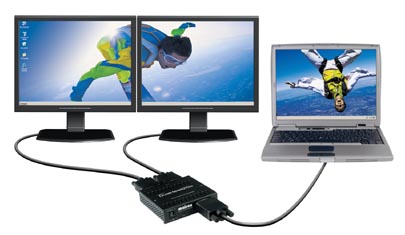Three's a crowd, but we love it
Here at HEXUS we love our multi-monitors. In fact, we scoff at single monitor configurations; why have one when you can have two... or three? Alas, dual screen monitors on laptops are, you might say, a little rare. You can, however, settle for using the laptop's TFT in conjunction with a secondary external TFT/CRT using the DVI/DSUB output of the laptop. Excellent, dual displays! Of course, the world has an insatiable appetite for more displays, so Matrox has devised a way of delivering tri-monitor capabilities to laptops.
DualHead2Go takes the single monitor output of your laptop (or indeed a single output from any other system) and provides a means of using two displays. We're not talking replicated displays here either, rather real dual display technology. Combine the DualHead2Go screens with the laptop's own screen and you have triple display technology. The device itself is very small and so easy to carry around with the laptop (let's ignore the requirement for extra monitors, though).

"How does it work, Steve?" I hear you shout. Matrox has been very cunning with the design of the DualHead2Go. The first thing to make clear is that it isn't a graphics card. It doesn't do any 2D or 3D calculations. The computer's graphics card is still charged with that task. Instead, the DualHead2Go box presents itself to the computer as a monitor. In fact, it presents itself as a potentially very wide monitor. So, the operating system and GPU output to a single monitor with a large horizontal pixel count, while the DualHead2Go box takes that signal and splits it across its own outputs to two real monitors.
If the device receives a more "traditional" signal, such as one at 1024x768 resolution, if that were to be spanned across two monitors it would look a bit odd. Instead the device will display the same image on both screens. Set the resolution to 2048x768, however, and you have yourself dual-screen output.
While we're sure you'll agree it's a cunning, yet relatively simple (in terms of the idea, at least) solution, there are certain drawbacks. One of the main targets of this device is laptop users. However, laptop graphics cards tend to be a little behind their desktop counterparts. That's shouldn't be too big a problem. Most laptop's graphics solutions should be able to output to a double-width monitor at a half decent resolution in 2D. However, don't expect much in the way of 3D action. Some of you will remember Matrox's Parhelia graphics card, once pushed as a tri-screen gaming solution. Rendering 3D across three screens is a taxing business which leads to lacklustre framerates at decent resolutions, and so the Parhelia was doomed to failure, in the eyes of gamers, at least.
These days Matrox has a name for itself for it's multi-display products and 2D capabilities. To that end we should look at this product in the light it was intended: as a productivity tool more than a 3D multi-display device. The design is certainly clever, and anyone who has had the pleasure of using multi-displays will agree that it will prove extremely useful. It will be interesting to see how people use the DualHead2Go 'in the wild'.
HEXUS.links
HEXUS.pr :: Matrox's press release.













